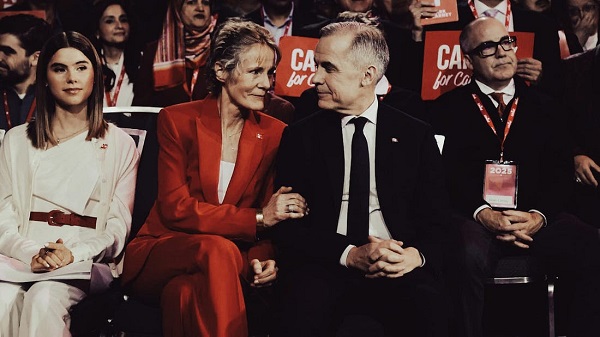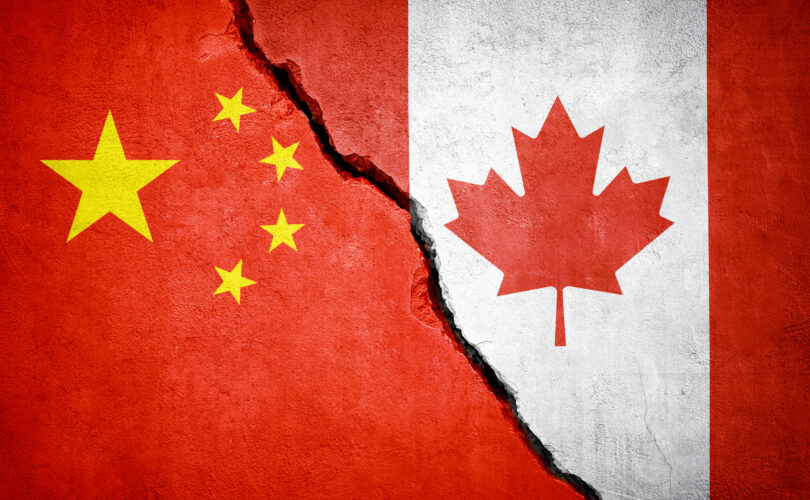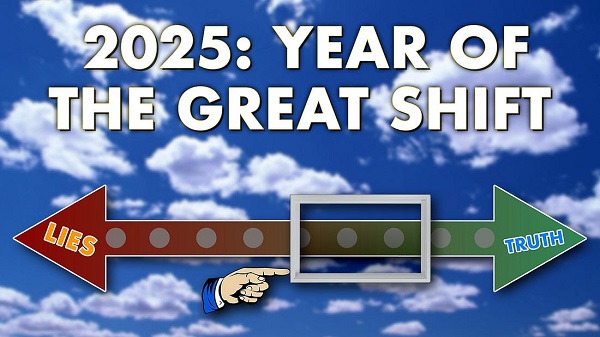Business
103 Conflicts and Counting Unprecedented Ethics Web of Prime Minister Mark Carney


 Dan Knight
Dan Knight
Brookfield. The PMO. Eurasia Group. One Green Agenda, Billions in Conflicts.
Well, it finally happened. After months of dodging questions and hiding behind vague platitudes about “climate leadership,” Prime Minister Mark Carney’s official conflict-of-interest screen has been released by the Ethics Commissioner—and what it reveals is nothing short of staggering. Not five entities. Not a dozen. One hundred and three. That’s how many corporate and financial interests Carney has quietly acknowledged are too conflicted for him to touch.
At the center of this web? Brookfield Asset Management, the $1 trillion global investment firm where Carney was Vice-Chair before walking straight into Canada’s top political office. The very same Brookfield that owns energy projects, pipelines, nuclear companies, real estate empires, carbon offset schemes you name it, they’ve got a piece of it. And now, they’ve got a former executive running the country.
We’re told it’s all perfectly legal. We’re told Carney has “recused himself.” But what this disclosure actually shows is something much bigger: a government captured by finance, a prime minister with deep, ongoing entanglements in the very sectors his policies now enrich, and a climate agenda that’s beginning to look a whole lot like a money-printing operation for the global elite.
The deeper one digs into Prime Minister Mark Carney’s ethics disclosure, the clearer the picture becomes: what’s been framed as a climate leadership story is, in reality, a tightly wound web of commercial interest wrapped in green rhetoric. The 103-entity conflict-of-interest screen, ostensibly a shield against impropriety, instead serves as a road map of how thoroughly Canada’s top political office is entangled in the global green finance complex centered around Brookfield Asset Management.
As of Q1 2025, Brookfield reports $125 billion in assets under management (AUM) in its Renewable Power & Transition segment, a figure representing 12.5% of its overall $1 trillion portfolio. This segment alone encompasses most of the entities on Carney’s ethics screen: nearly 60 out of 103, even after accounting for duplicates. These aren’t passive holdings they’re the very projects, technologies, and subsidy-eligible vehicles Carney once oversaw directly as vice-chair of Brookfield and as co-lead of its $15 billion Global Transition Fund.
Brookfield’s renewables portfolio is vast: over 41.8 GW in installed capacity globally across wind, solar, hydro, and storage, with a 200+ GW development pipeline. A significant portion of this is owned or operated through the same SPVs and subsidiaries now appearing on the conflict list. Notable entries include Scout Clean Energy ($1B), Urban Grid ($650M), and Standard Solar ($540M). These acquisitions were all completed while Carney was at Brookfield, and they continue to generate revenue from U.S. and Canadian subsidy frameworks programs now shaped by the very government he leads.
Brookfield Renewable Partners L.P., the sector flagship, holds approximately $95 billion in total assets and generated $315 million in funds from operations in Q1 2025 alone. The firm is planning to add another 8 GW in capacity this year expansion that is, in part, subsidized through the same green transition policies Carney has promoted both in office and as a climate finance advocate.
The line between public and private interest blurs even further when examining the entities categorized under the “energy transition” banner; nuclear, CCS (carbon capture and storage), and so-called e-fuels. Carney’s screen includes Brookfield’s recent $8 billion acquisition of Westinghouse Electric Company, a nuclear power behemoth now positioned to benefit from Canada’s federal nuclear incentives and SMR (small modular reactor) program. Other flagged investments like Entropy and Carbon TerraVault fall directly into carbon credit and offset schemes—markets heavily influenced by federal regulation and incentive design.
Let’s stop pretending. What we’re witnessing here isn’t just conflict of interest, it’s a complete merger of state power and corporate ambition, all dressed up in the language of moral urgency. The Ethics Commissioner’s so-called “screen” for Mark Carney? It’s a joke. A checklist. A bureaucratic fig leaf meant to reassure you that everything’s above board. But it’s not.
Because here’s the truth: Carney is policing himself. He’s supposed to recuse himself from decisions that benefit the 103 entities he’s tied to many of which he helped create or oversee as Vice-Chair of Brookfield Asset Management. But who decides if he’s in conflict? He does. Or more accurately, the PMO does. The same PMO now drafting Dominion Barton-style focus groups to figure out how best to sell you the green grift. There’s no third-party oversight, no transparency on what’s actually in his so-called blind trust, and no disclosure of the carried interest he may still be entitled to from Brookfield’s billions in funds.
Meanwhile, the policy levers of government are being pulled in exactly the direction Brookfield bet on. Wind, solar, carbon capture, nuclear, every so-called “transition” sector that Brookfield spent years buying into is now flush with green subsidies, ESG guarantees, and taxpayer-backed investment shields. This isn’t the free market at work, it’s a strategic payoff, engineered by someone who’s now running one of the most powerful G7 economies.
And again, none of it is illegal. That’s the most damning part. Because legality isn’t the standard here. The standard is integrity, and that’s nowhere to be found. The scale of this overlap isn’t just large. It’s systemic. It’s built into the very foundation of the Carney government’s climate policy. The same man who structured these funds is now the man signing off on the policies that make them profitable.
Diana Fox Carney’s Quiet Role in the Climate Cash Machine
And just when you thought the web of influence stopped at the Prime Minister himself, along comes Diana Fox Carney, economist, climate consultant, and spouse of the most well-connected man in Canadian politics. While Mark Carney’s direct financial entanglements with Brookfield Asset Management are now public record, his wife’s career trajectory paints an equally troubling picture of how the same elite networks driving Canada’s green spending are profiting in parallel, behind the curtain.
Diana Fox Carney currently holds a senior advisory role at Eurasia Group, the New York-based geopolitical risk consultancy that’s become a quiet powerhouse in shaping global ESG narratives. It’s also the same firm where Gerald Butts—Trudeau’s longtime fixer and architect of the federal climate playbook—now serves as vice chair. Add in former journalist Evan Solomon and even Conservative stalwart John Baird, and you’ve got a bipartisan consultancy stacked with Canadian political operators. Convenient? Maybe. Coordinated? You decide.
And what has this firm staffed with Liberal-era insiders received in return? Millions in untendered government contracts, including a $446,210 deal from Natural Resources Canada in 2024 for vaguely defined “geopolitical research.” That’s nearly half a million dollars in taxpayer money handed out without competition, to a firm employing the sitting Prime Minister’s wife—and his former colleagues. Just coincidence, right?
But Eurasia Group is only the start. Diana’s reach extends far beyond advisory calls. She’s connected to:
- BeyondNetZero, a climate equity fund backed by U.S. private capital giant General Atlantic.
- Helios CLEAR, investing in African climate “resilience.”
- ClientEarth U.S. and the Shell Foundation, both pushing aggressive environmental litigation and policy influence.
- Canada 2020, a Trudeau-aligned think tank that’s pocketed over $1 million in federal grants.
Throw in indirect ties to Gates Foundation funding, Save the Children, and research networks influencing African agriculture, and you’re looking at a network of transnational climate consultants with deep, ongoing influence over the exact climate policies the federal government is now implementing under her husband’s leadership.
Now, legally, Diana is in the clear. She’s not a public office holder. But that’s the point. The rules weren’t designed for this new class of political operator—the dual-career globalist power couple, where one side signs the climate cheques while the other cashes them. No formal disclosure is required. No recusals. No transparency. Yet the influence is there. The access is there. The money is flowing.
Opposition Reaction: Pierre Poilievre Slams Carney’s Hidden Conflicts, Demands Real Transparency
Conservative Leader Pierre Poilievre wasted no time responding to the bombshell ethics screen showing Prime Minister Mark Carney is recusing himself from dealings with over 100 companies, many tied to his former employer, Brookfield Asset Management. In a pair of direct and widely shared posts, Poilievre accused Carney of concealing critical financial entanglements from voters during the 2025 election, and warned that the Liberal leader is now either positioned to profit from federal decisions or paralyzed from making them.
“Mark Carney must explain why he kept these conflicts secret from voters until after the election,” Poilievre wrote. “Now he will be in a position to profit from big decisions or will be forced to sit out those decisions altogether. Either way, Canadians will pay the price.”
In a second post earlier that morning, Poilievre challenged the credibility of Carney’s so-called blind trust, urging the Prime Minister to liquidate his holdings entirely and hand the cash to a trustee who can invest it without Carney’s knowledge or influence:
“Otherwise, he will always know how political decisions can affect his personal wealth.”
These statements mark the strongest opposition rebuke yet of the Carney government’s financial entanglements. Poilievre’s message echoes growing public criticism that the ethics screen is little more than window dressing, lacking third-party oversight, and that it fails to address indirect benefit through carried interest, deferred compensation, or spousal affiliations.
While Carney has claimed he is in full compliance with federal ethics laws, the fact that the disclosures were released only after the election is fueling outrage—not just among Conservatives but from broader accountability watchdogs. With over 100 entities flagged, many of them tied to green energy, infrastructure, and climate finance—the same sectors receiving billions in federal spending—the Conservative leader has positioned himself as the voice of those demanding a full forensic audit of the Prime Minister’s interests.
The message from the opposition is clear: if this were a Conservative leader, the media would be calling it a scandal. But because it’s Carney—the global banker, the climate envoy, the Liberal savior—the establishment is looking the other way. Poilievre’s Conservatives aren’t. And they’re turning this into a defining issue of integrity and accountability in Canadian politics.
Let’s Call This What It Is
This isn’t subtle. This isn’t nuanced. This is what a grift looks like—on paper, in public, in black and white. Over one hundred conflicts of interest tied directly to Mark Carney. Entire portfolios of foreign and domestic holdings, billions in green investments, shell companies in Bermuda—and that’s before we even get to his wife’s global consultancy work, advising firms that quietly gobble up federal contracts without a single public tender.
And here’s the thing: we weren’t told any of this during the election. There was no press conference, no headline, no public vetting of the sprawling web of corporate and climate interests now tied to the highest office in the country. Why? Because it would have compromised the Liberal grip on power. Because the last thing this party wanted Canadians to know was that their new leader wasn’t just a banker—but a banker with a boardroom’s worth of financial strings still attached.
Now imagine—just for a moment—if it had been Pierre Poilievre. Or Andrew Scheer. Or any Conservative leader with over a hundred screened entities, global finance ties, offshore SPVs, and a spouse employed by a company collecting millions in government money. The press would be in a frenzy. The CBC would be running specials. They’d be calling him compromised, unfit, a foreign agent.
But because it’s their guy—because it’s the Liberal elite’s banker-in-chief—we’re told it’s fine. It’s all above board. Move along, nothing to see here.
Nonsense. Absolute nonsense.
This is not leadership. This is ideological grifting at the highest level. The Liberal Party, once the party of national unity and democratic accountability, has become a hollowed-out machine for elite interests. They’re not liberals. They’re grifters—grifting for green subsidies, globalist contracts, and personal access to power. They have no principle left. Just consultants, contracts, and a taxpayer-funded narrative to keep the game going.
Enough. Canadians didn’t vote for this. They weren’t told the truth. And now the entire climate agenda, the whole “just transition,” looks more like a get-rich scheme for the political class than any serious public mission.
It’s time for an election. Time to clear house. Time to drain this toxic, green-glossed swamp once and for all.
Subscribe to The Opposition with Dan Knight
Invite your friends and earn rewards
Business
Largest fraud in US history? Independent Journalist visits numerous daycare centres with no children, revealing massive scam

A young journalist has uncovered perhaps the largest fraud scheme in US history.
He certainly isn’t a polished reporter with many years of experience, but 23 year old independent journalist Nick Shirley seems to be getting the job done. Shirley has released an incredible video which appears to outline fraud after fraud after fraud in what appears to be a massive taxpayer funded scheme involving up to $9 Billion Dollars.
In one day of traveling around Minneapolis-St. Paul, Shirley appears to uncover over $100 million in fraudulent operations.
🚨 Here is the full 42 minutes of my crew and I exposing Minnesota fraud, this might be my most important work yet. We uncovered over $110,000,000 in ONE day. Like it and share it around like wildfire! Its time to hold these corrupt politicians and fraudsters accountable
We ALL… pic.twitter.com/E3Penx2o7a
— Nick shirley (@nickshirleyy) December 26, 2025
Business
“Magnitude cannot be overstated”: Minnesota aid scam may reach $9 billion

Federal prosecutors say Minnesota’s exploding social-services fraud scandal may now rival nearly the entire economy of Somalia, with as much as $9 billion allegedly stolen from taxpayer-funded programs in what authorities describe as industrial-scale abuse that unfolded largely under the watch of Democrat Gov. Tim Walz. The staggering new estimate is almost nine times higher than the roughly $1 billion figure previously suspected and amounts to about half of the $18 billion in federal funds routed through Minnesota-run social-services programs since 2018, according to prosecutors. “The magnitude cannot be overstated,” First Assistant U.S. Attorney Joe Thompson said Thursday, stressing that investigators are still uncovering massive schemes. “This is not a handful of bad actors. It’s staggering, industrial-scale fraud. Every day we look under a rock and find another $50 million fraud operation.”
Authorities say the alleged theft went far beyond routine overbilling. Dozens of defendants — the vast majority tied to Minnesota’s Somali community — are accused of creating sham businesses and nonprofits that claimed to provide housing assistance, food aid, or health-care services that never existed, then billing state programs backed by federal dollars. Thompson said the opportunity became so lucrative it attracted what he called “fraud tourism,” with out-of-state operators traveling to Minnesota to cash in. Charges announced Thursday against six more people bring the total number of defendants to 92.
BREAKING: First Assistant U.S. Attorney Joe Thompson revealed that 14 state Medicaid programs have cost Minnesota $18 billion since 2018, including more than $3.5 billion in 2024 alone.
Thompson stated, "Now, I'm sure everyone is wondering how much of this $18 billion was… pic.twitter.com/hCNDBuCTYH
— FOX 9 (@FOX9) December 18, 2025
Among the newly charged are Anthony Waddell Jefferson, 37, and Lester Brown, 53, who prosecutors say traveled from Philadelphia to Minnesota after spotting what they believed was easy money in the state’s housing assistance system. The pair allegedly embedded themselves in shelters and affordable-housing networks to pose as legitimate providers, then recruited relatives and associates to fabricate client notes. Prosecutors say they submitted about $3.5 million in false claims to the state’s Housing Stability Services Program for roughly 230 supposed clients.
Other cases show how deeply the alleged fraud penetrated Minnesota’s health-care programs. Abdinajib Hassan Yussuf, 27, is accused of setting up a bogus autism therapy nonprofit that paid parents to enroll children regardless of diagnosis, then billed the state for services never delivered, netting roughly $6 million. Another defendant, Asha Farhan Hassan, 28, allegedly participated in a separate autism scheme that generated $14 million in fraudulent reimbursements, while also pocketing nearly $500,000 through the notorious Feeding Our Future food-aid scandal. “Roughly two dozen Feeding Our Future defendants were getting money from autism clinics,” Thompson said. “That’s how we learned about the autism fraud.”
The broader scandal began to unravel in 2022 when Feeding Our Future collapsed under federal investigation, but prosecutors say only in recent months has the true scope of the alleged theft come into focus. Investigators allege large sums were wired overseas or spent on luxury vehicles and other high-end purchases. The revelations have fueled political fallout in Minnesota and prompted renewed federal scrutiny of immigration-linked fraud as well as criticism of state oversight failures. Walz, who is seeking re-election in 2026 after serving as Kamala Harris’ running mate in 2024, defended his administration Thursday, saying, “We will not tolerate fraud, and we will continue to work with federal partners to ensure fraud is stopped and fraudsters are caught.” Prosecutors, however, made clear the investigation is far from finished — and warned the final tally could climb even higher.
-

 International21 hours ago
International21 hours agoOttawa is still dodging the China interference threat
-

 Business19 hours ago
Business19 hours agoThere’s No Bias at CBC News, You Say? Well, OK…
-

 Automotive18 hours ago
Automotive18 hours agoCanada’s EV gamble is starting to backfire
-

 International20 hours ago
International20 hours ago2025: The Year The Narrative Changed
-

 Fraser Institute2 days ago
Fraser Institute2 days agoCarney government sowing seeds for corruption in Ottawa
-

 Daily Caller2 days ago
Daily Caller2 days agoWhile Western Nations Cling to Energy Transition, Pragmatic Nations Produce Energy and Wealth
-

 Alberta2 days ago
Alberta2 days agoAlberta Next Panel calls for less Ottawa—and it could pay off
-

 Business1 day ago
Business1 day agoResidents in economically free states reap the rewards






